Organizational Culture and Structure Analysis: Facebook Case Study
VerifiedAdded on 2023/03/23
|16
|3815
|100
Report
AI Summary
This report provides an in-depth analysis of Facebook's organizational culture and structure, focusing on key elements such as departmentalization, chain of command, span of control, centralization/decentralization, work specialization, and formalization. The study examines how these structural dimensions contribute to Facebook's operational effectiveness. The report also explores contingency factors, including strategy, environment, organizational size, and technology, and their influence on the company's organizational design. The analysis highlights Facebook's flexible approach to departmentalization, its fluid chain of command, the use of smaller teams, the inclination towards decentralization, and the implementation of low work specialization. Furthermore, the report discusses the non-formal job roles and emphasis on employee collaboration. Overall, the report provides valuable insights into the organizational structure of Facebook and its impact on the company's performance, aligning with the HI6005 Management and Organizations in a Global Environment course requirements.
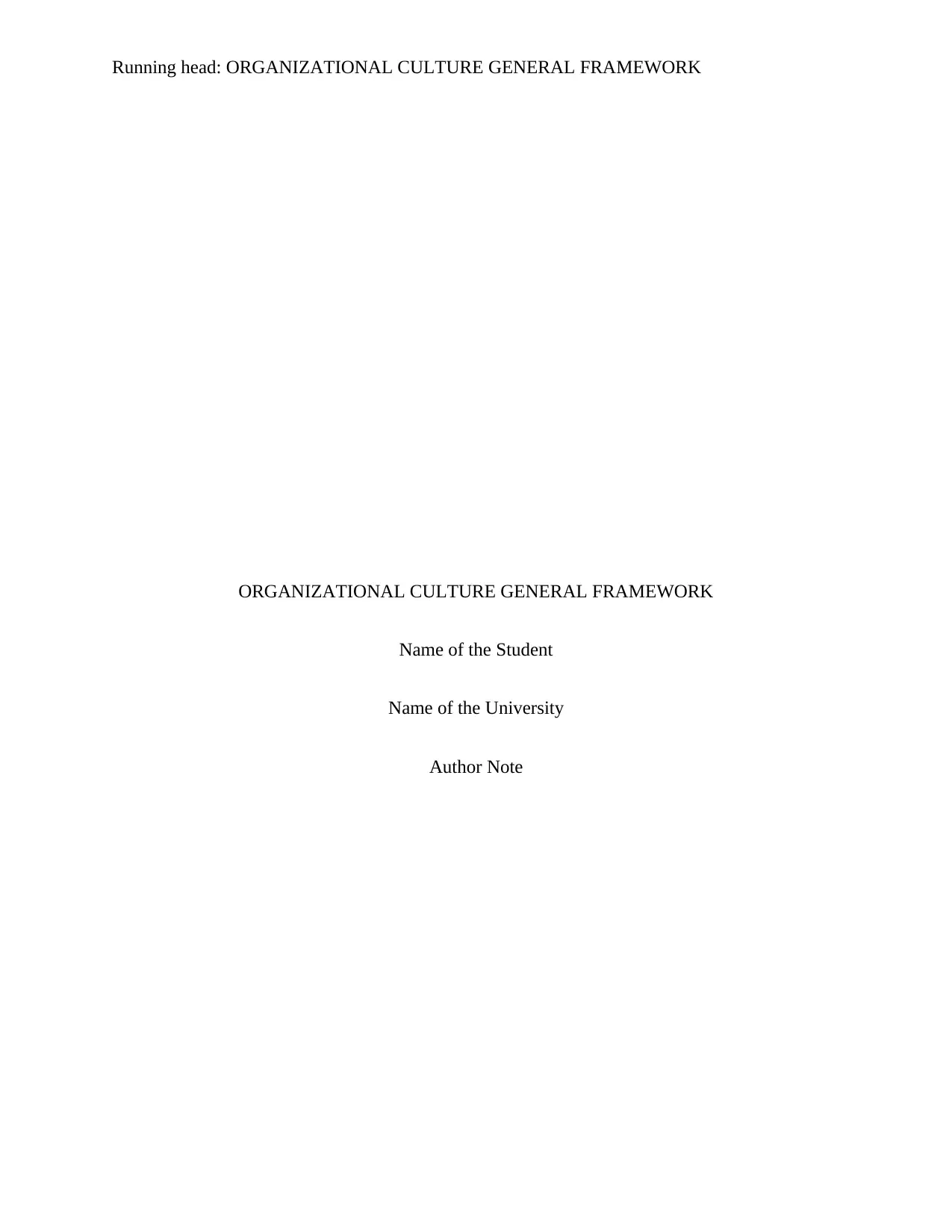
Running head: ORGANIZATIONAL CULTURE GENERAL FRAMEWORK
ORGANIZATIONAL CULTURE GENERAL FRAMEWORK
Name of the Student
Name of the University
Author Note
ORGANIZATIONAL CULTURE GENERAL FRAMEWORK
Name of the Student
Name of the University
Author Note
Paraphrase This Document
Need a fresh take? Get an instant paraphrase of this document with our AI Paraphraser
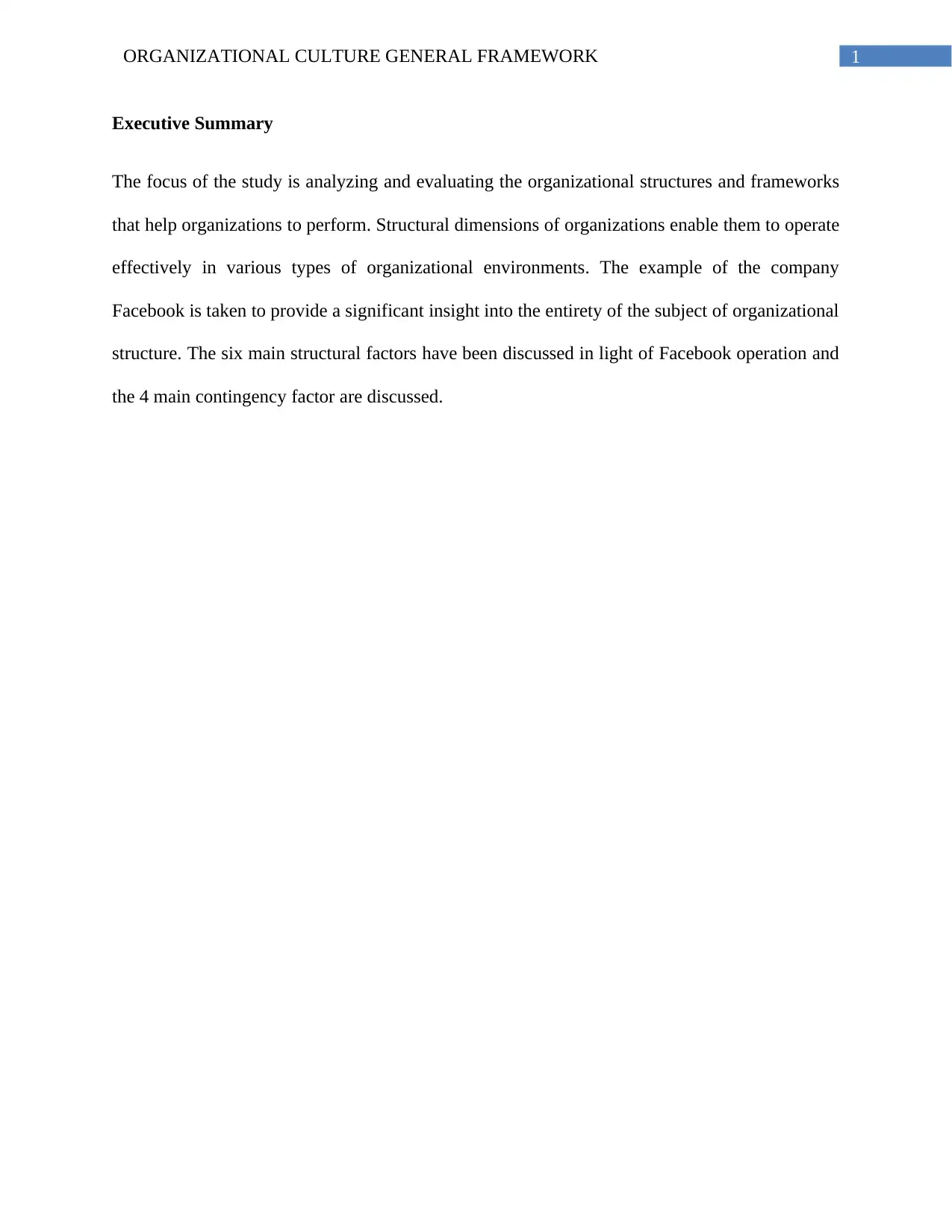
1ORGANIZATIONAL CULTURE GENERAL FRAMEWORK
Executive Summary
The focus of the study is analyzing and evaluating the organizational structures and frameworks
that help organizations to perform. Structural dimensions of organizations enable them to operate
effectively in various types of organizational environments. The example of the company
Facebook is taken to provide a significant insight into the entirety of the subject of organizational
structure. The six main structural factors have been discussed in light of Facebook operation and
the 4 main contingency factor are discussed.
Executive Summary
The focus of the study is analyzing and evaluating the organizational structures and frameworks
that help organizations to perform. Structural dimensions of organizations enable them to operate
effectively in various types of organizational environments. The example of the company
Facebook is taken to provide a significant insight into the entirety of the subject of organizational
structure. The six main structural factors have been discussed in light of Facebook operation and
the 4 main contingency factor are discussed.
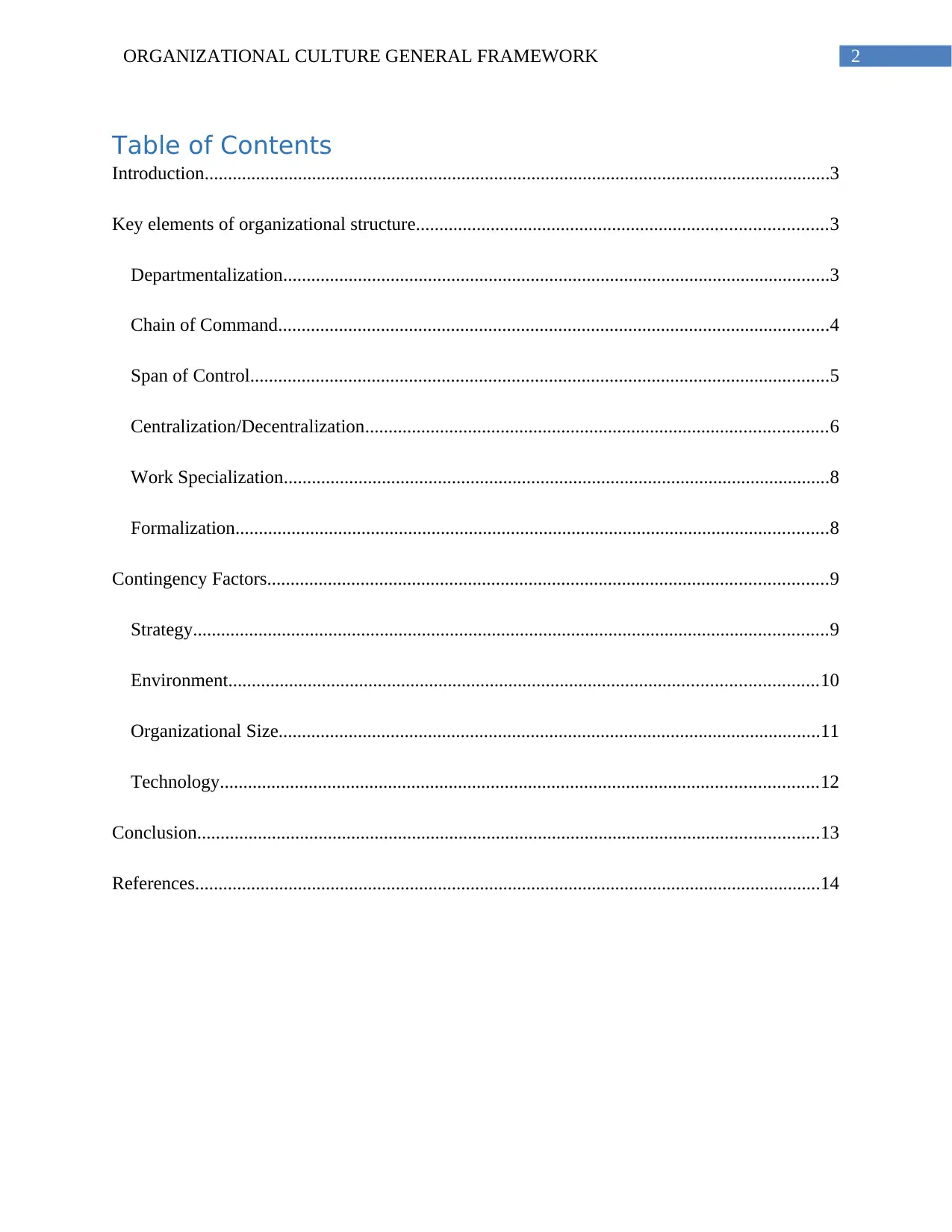
2ORGANIZATIONAL CULTURE GENERAL FRAMEWORK
Table of Contents
Introduction......................................................................................................................................3
Key elements of organizational structure........................................................................................3
Departmentalization.....................................................................................................................3
Chain of Command......................................................................................................................4
Span of Control............................................................................................................................5
Centralization/Decentralization...................................................................................................6
Work Specialization.....................................................................................................................8
Formalization...............................................................................................................................8
Contingency Factors........................................................................................................................9
Strategy........................................................................................................................................9
Environment..............................................................................................................................10
Organizational Size....................................................................................................................11
Technology................................................................................................................................12
Conclusion.....................................................................................................................................13
References......................................................................................................................................14
Table of Contents
Introduction......................................................................................................................................3
Key elements of organizational structure........................................................................................3
Departmentalization.....................................................................................................................3
Chain of Command......................................................................................................................4
Span of Control............................................................................................................................5
Centralization/Decentralization...................................................................................................6
Work Specialization.....................................................................................................................8
Formalization...............................................................................................................................8
Contingency Factors........................................................................................................................9
Strategy........................................................................................................................................9
Environment..............................................................................................................................10
Organizational Size....................................................................................................................11
Technology................................................................................................................................12
Conclusion.....................................................................................................................................13
References......................................................................................................................................14
⊘ This is a preview!⊘
Do you want full access?
Subscribe today to unlock all pages.

Trusted by 1+ million students worldwide
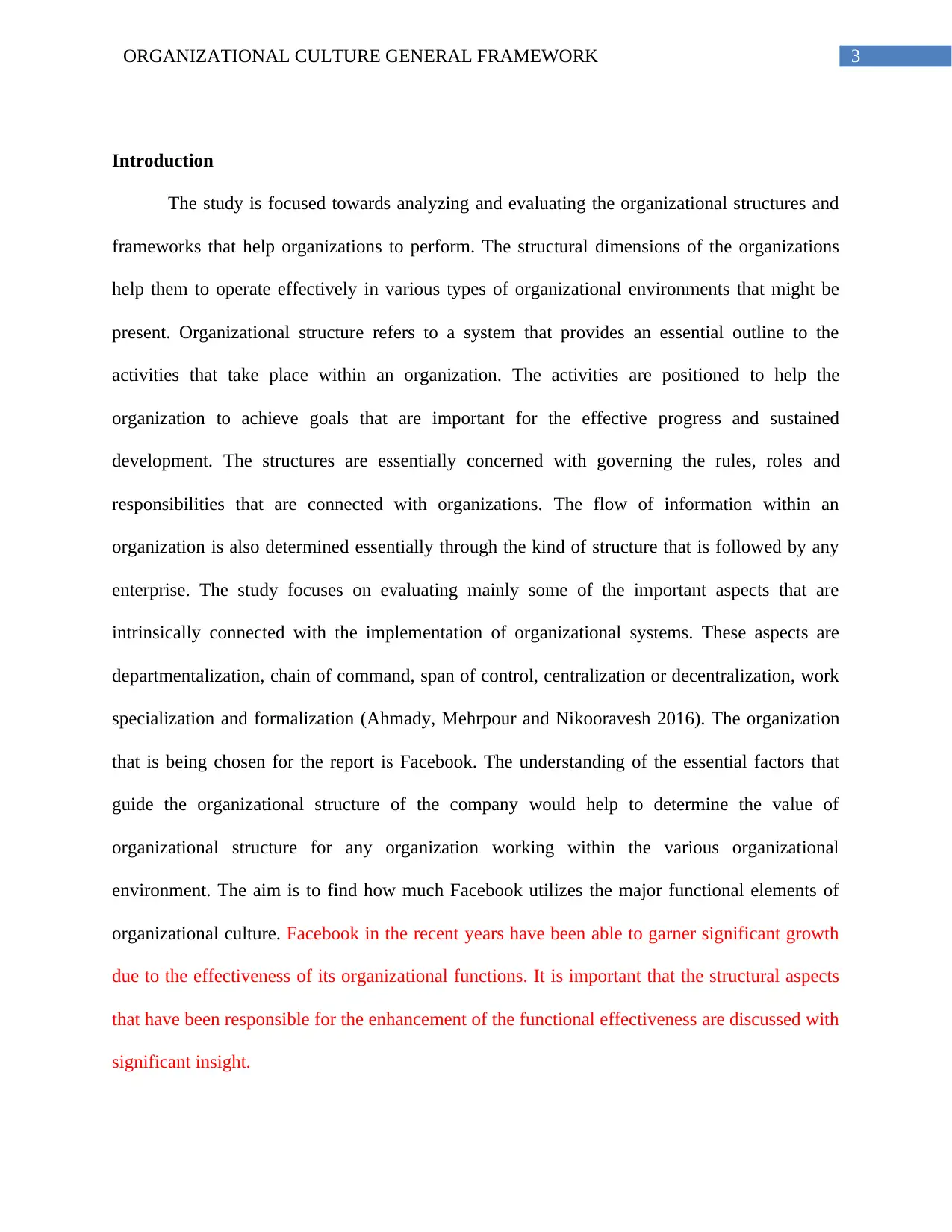
3ORGANIZATIONAL CULTURE GENERAL FRAMEWORK
Introduction
The study is focused towards analyzing and evaluating the organizational structures and
frameworks that help organizations to perform. The structural dimensions of the organizations
help them to operate effectively in various types of organizational environments that might be
present. Organizational structure refers to a system that provides an essential outline to the
activities that take place within an organization. The activities are positioned to help the
organization to achieve goals that are important for the effective progress and sustained
development. The structures are essentially concerned with governing the rules, roles and
responsibilities that are connected with organizations. The flow of information within an
organization is also determined essentially through the kind of structure that is followed by any
enterprise. The study focuses on evaluating mainly some of the important aspects that are
intrinsically connected with the implementation of organizational systems. These aspects are
departmentalization, chain of command, span of control, centralization or decentralization, work
specialization and formalization (Ahmady, Mehrpour and Nikooravesh 2016). The organization
that is being chosen for the report is Facebook. The understanding of the essential factors that
guide the organizational structure of the company would help to determine the value of
organizational structure for any organization working within the various organizational
environment. The aim is to find how much Facebook utilizes the major functional elements of
organizational culture. Facebook in the recent years have been able to garner significant growth
due to the effectiveness of its organizational functions. It is important that the structural aspects
that have been responsible for the enhancement of the functional effectiveness are discussed with
significant insight.
Introduction
The study is focused towards analyzing and evaluating the organizational structures and
frameworks that help organizations to perform. The structural dimensions of the organizations
help them to operate effectively in various types of organizational environments that might be
present. Organizational structure refers to a system that provides an essential outline to the
activities that take place within an organization. The activities are positioned to help the
organization to achieve goals that are important for the effective progress and sustained
development. The structures are essentially concerned with governing the rules, roles and
responsibilities that are connected with organizations. The flow of information within an
organization is also determined essentially through the kind of structure that is followed by any
enterprise. The study focuses on evaluating mainly some of the important aspects that are
intrinsically connected with the implementation of organizational systems. These aspects are
departmentalization, chain of command, span of control, centralization or decentralization, work
specialization and formalization (Ahmady, Mehrpour and Nikooravesh 2016). The organization
that is being chosen for the report is Facebook. The understanding of the essential factors that
guide the organizational structure of the company would help to determine the value of
organizational structure for any organization working within the various organizational
environment. The aim is to find how much Facebook utilizes the major functional elements of
organizational culture. Facebook in the recent years have been able to garner significant growth
due to the effectiveness of its organizational functions. It is important that the structural aspects
that have been responsible for the enhancement of the functional effectiveness are discussed with
significant insight.
Paraphrase This Document
Need a fresh take? Get an instant paraphrase of this document with our AI Paraphraser
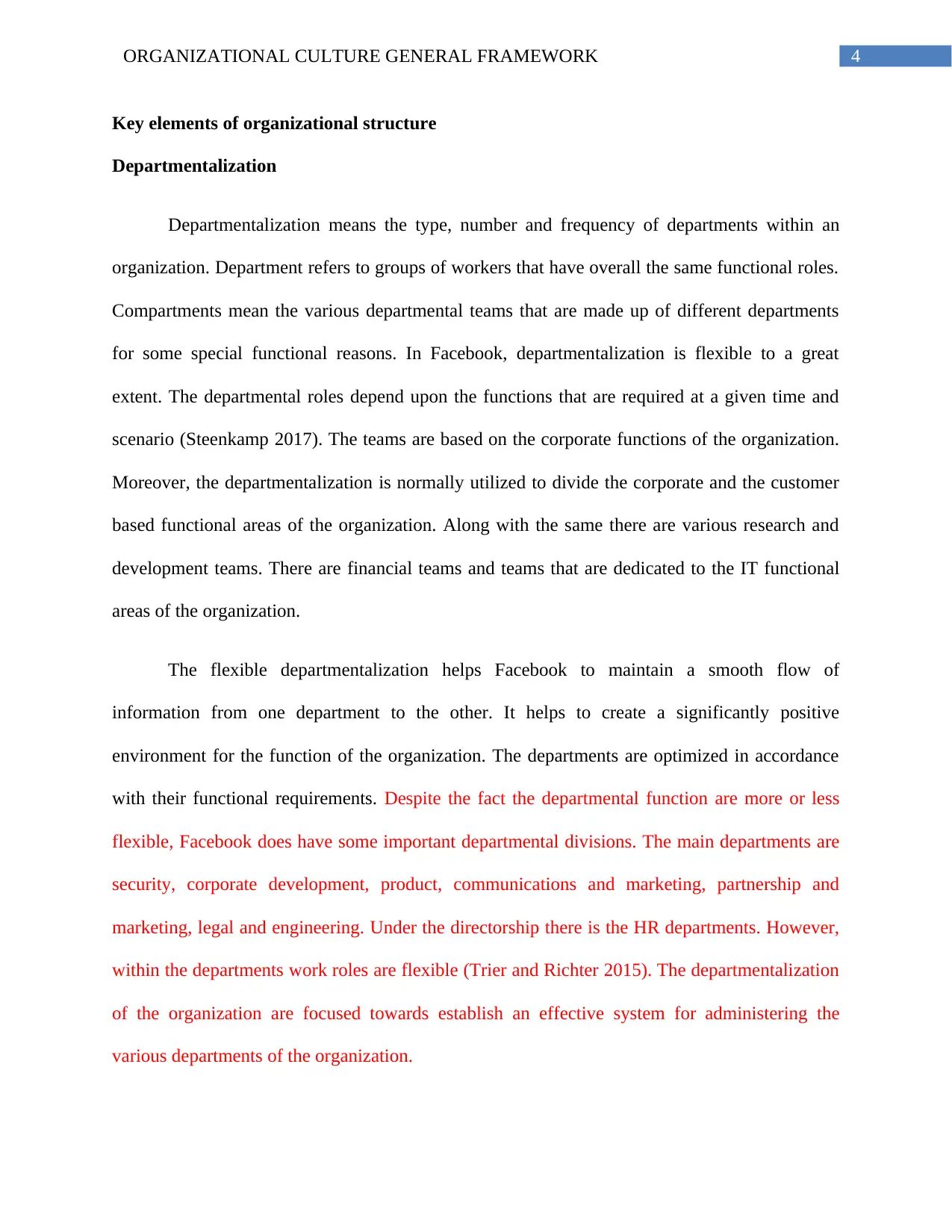
4ORGANIZATIONAL CULTURE GENERAL FRAMEWORK
Key elements of organizational structure
Departmentalization
Departmentalization means the type, number and frequency of departments within an
organization. Department refers to groups of workers that have overall the same functional roles.
Compartments mean the various departmental teams that are made up of different departments
for some special functional reasons. In Facebook, departmentalization is flexible to a great
extent. The departmental roles depend upon the functions that are required at a given time and
scenario (Steenkamp 2017). The teams are based on the corporate functions of the organization.
Moreover, the departmentalization is normally utilized to divide the corporate and the customer
based functional areas of the organization. Along with the same there are various research and
development teams. There are financial teams and teams that are dedicated to the IT functional
areas of the organization.
The flexible departmentalization helps Facebook to maintain a smooth flow of
information from one department to the other. It helps to create a significantly positive
environment for the function of the organization. The departments are optimized in accordance
with their functional requirements. Despite the fact the departmental function are more or less
flexible, Facebook does have some important departmental divisions. The main departments are
security, corporate development, product, communications and marketing, partnership and
marketing, legal and engineering. Under the directorship there is the HR departments. However,
within the departments work roles are flexible (Trier and Richter 2015). The departmentalization
of the organization are focused towards establish an effective system for administering the
various departments of the organization.
Key elements of organizational structure
Departmentalization
Departmentalization means the type, number and frequency of departments within an
organization. Department refers to groups of workers that have overall the same functional roles.
Compartments mean the various departmental teams that are made up of different departments
for some special functional reasons. In Facebook, departmentalization is flexible to a great
extent. The departmental roles depend upon the functions that are required at a given time and
scenario (Steenkamp 2017). The teams are based on the corporate functions of the organization.
Moreover, the departmentalization is normally utilized to divide the corporate and the customer
based functional areas of the organization. Along with the same there are various research and
development teams. There are financial teams and teams that are dedicated to the IT functional
areas of the organization.
The flexible departmentalization helps Facebook to maintain a smooth flow of
information from one department to the other. It helps to create a significantly positive
environment for the function of the organization. The departments are optimized in accordance
with their functional requirements. Despite the fact the departmental function are more or less
flexible, Facebook does have some important departmental divisions. The main departments are
security, corporate development, product, communications and marketing, partnership and
marketing, legal and engineering. Under the directorship there is the HR departments. However,
within the departments work roles are flexible (Trier and Richter 2015). The departmentalization
of the organization are focused towards establish an effective system for administering the
various departments of the organization.
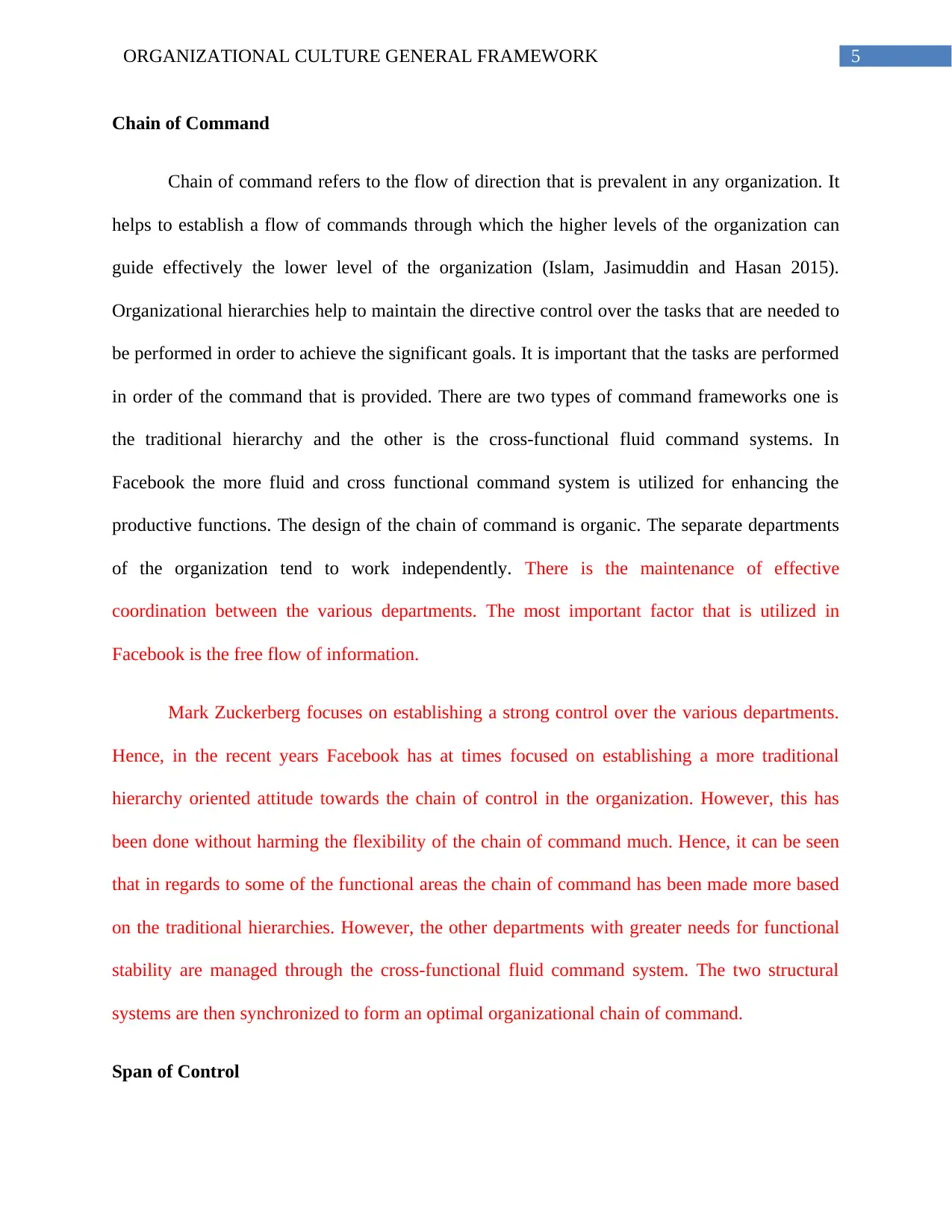
5ORGANIZATIONAL CULTURE GENERAL FRAMEWORK
Chain of Command
Chain of command refers to the flow of direction that is prevalent in any organization. It
helps to establish a flow of commands through which the higher levels of the organization can
guide effectively the lower level of the organization (Islam, Jasimuddin and Hasan 2015).
Organizational hierarchies help to maintain the directive control over the tasks that are needed to
be performed in order to achieve the significant goals. It is important that the tasks are performed
in order of the command that is provided. There are two types of command frameworks one is
the traditional hierarchy and the other is the cross-functional fluid command systems. In
Facebook the more fluid and cross functional command system is utilized for enhancing the
productive functions. The design of the chain of command is organic. The separate departments
of the organization tend to work independently. There is the maintenance of effective
coordination between the various departments. The most important factor that is utilized in
Facebook is the free flow of information.
Mark Zuckerberg focuses on establishing a strong control over the various departments.
Hence, in the recent years Facebook has at times focused on establishing a more traditional
hierarchy oriented attitude towards the chain of control in the organization. However, this has
been done without harming the flexibility of the chain of command much. Hence, it can be seen
that in regards to some of the functional areas the chain of command has been made more based
on the traditional hierarchies. However, the other departments with greater needs for functional
stability are managed through the cross-functional fluid command system. The two structural
systems are then synchronized to form an optimal organizational chain of command.
Span of Control
Chain of Command
Chain of command refers to the flow of direction that is prevalent in any organization. It
helps to establish a flow of commands through which the higher levels of the organization can
guide effectively the lower level of the organization (Islam, Jasimuddin and Hasan 2015).
Organizational hierarchies help to maintain the directive control over the tasks that are needed to
be performed in order to achieve the significant goals. It is important that the tasks are performed
in order of the command that is provided. There are two types of command frameworks one is
the traditional hierarchy and the other is the cross-functional fluid command systems. In
Facebook the more fluid and cross functional command system is utilized for enhancing the
productive functions. The design of the chain of command is organic. The separate departments
of the organization tend to work independently. There is the maintenance of effective
coordination between the various departments. The most important factor that is utilized in
Facebook is the free flow of information.
Mark Zuckerberg focuses on establishing a strong control over the various departments.
Hence, in the recent years Facebook has at times focused on establishing a more traditional
hierarchy oriented attitude towards the chain of control in the organization. However, this has
been done without harming the flexibility of the chain of command much. Hence, it can be seen
that in regards to some of the functional areas the chain of command has been made more based
on the traditional hierarchies. However, the other departments with greater needs for functional
stability are managed through the cross-functional fluid command system. The two structural
systems are then synchronized to form an optimal organizational chain of command.
Span of Control
⊘ This is a preview!⊘
Do you want full access?
Subscribe today to unlock all pages.

Trusted by 1+ million students worldwide
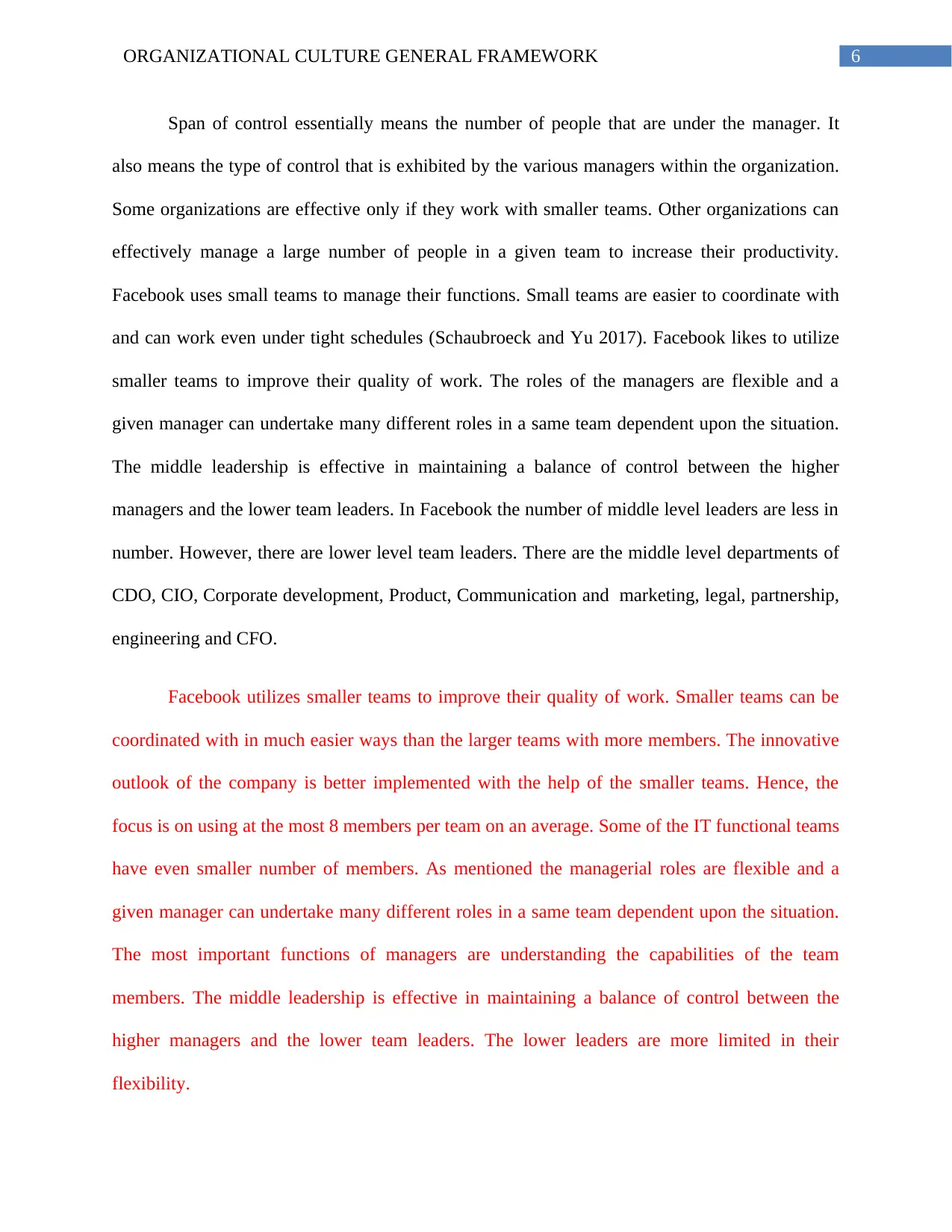
6ORGANIZATIONAL CULTURE GENERAL FRAMEWORK
Span of control essentially means the number of people that are under the manager. It
also means the type of control that is exhibited by the various managers within the organization.
Some organizations are effective only if they work with smaller teams. Other organizations can
effectively manage a large number of people in a given team to increase their productivity.
Facebook uses small teams to manage their functions. Small teams are easier to coordinate with
and can work even under tight schedules (Schaubroeck and Yu 2017). Facebook likes to utilize
smaller teams to improve their quality of work. The roles of the managers are flexible and a
given manager can undertake many different roles in a same team dependent upon the situation.
The middle leadership is effective in maintaining a balance of control between the higher
managers and the lower team leaders. In Facebook the number of middle level leaders are less in
number. However, there are lower level team leaders. There are the middle level departments of
CDO, CIO, Corporate development, Product, Communication and marketing, legal, partnership,
engineering and CFO.
Facebook utilizes smaller teams to improve their quality of work. Smaller teams can be
coordinated with in much easier ways than the larger teams with more members. The innovative
outlook of the company is better implemented with the help of the smaller teams. Hence, the
focus is on using at the most 8 members per team on an average. Some of the IT functional teams
have even smaller number of members. As mentioned the managerial roles are flexible and a
given manager can undertake many different roles in a same team dependent upon the situation.
The most important functions of managers are understanding the capabilities of the team
members. The middle leadership is effective in maintaining a balance of control between the
higher managers and the lower team leaders. The lower leaders are more limited in their
flexibility.
Span of control essentially means the number of people that are under the manager. It
also means the type of control that is exhibited by the various managers within the organization.
Some organizations are effective only if they work with smaller teams. Other organizations can
effectively manage a large number of people in a given team to increase their productivity.
Facebook uses small teams to manage their functions. Small teams are easier to coordinate with
and can work even under tight schedules (Schaubroeck and Yu 2017). Facebook likes to utilize
smaller teams to improve their quality of work. The roles of the managers are flexible and a
given manager can undertake many different roles in a same team dependent upon the situation.
The middle leadership is effective in maintaining a balance of control between the higher
managers and the lower team leaders. In Facebook the number of middle level leaders are less in
number. However, there are lower level team leaders. There are the middle level departments of
CDO, CIO, Corporate development, Product, Communication and marketing, legal, partnership,
engineering and CFO.
Facebook utilizes smaller teams to improve their quality of work. Smaller teams can be
coordinated with in much easier ways than the larger teams with more members. The innovative
outlook of the company is better implemented with the help of the smaller teams. Hence, the
focus is on using at the most 8 members per team on an average. Some of the IT functional teams
have even smaller number of members. As mentioned the managerial roles are flexible and a
given manager can undertake many different roles in a same team dependent upon the situation.
The most important functions of managers are understanding the capabilities of the team
members. The middle leadership is effective in maintaining a balance of control between the
higher managers and the lower team leaders. The lower leaders are more limited in their
flexibility.
Paraphrase This Document
Need a fresh take? Get an instant paraphrase of this document with our AI Paraphraser
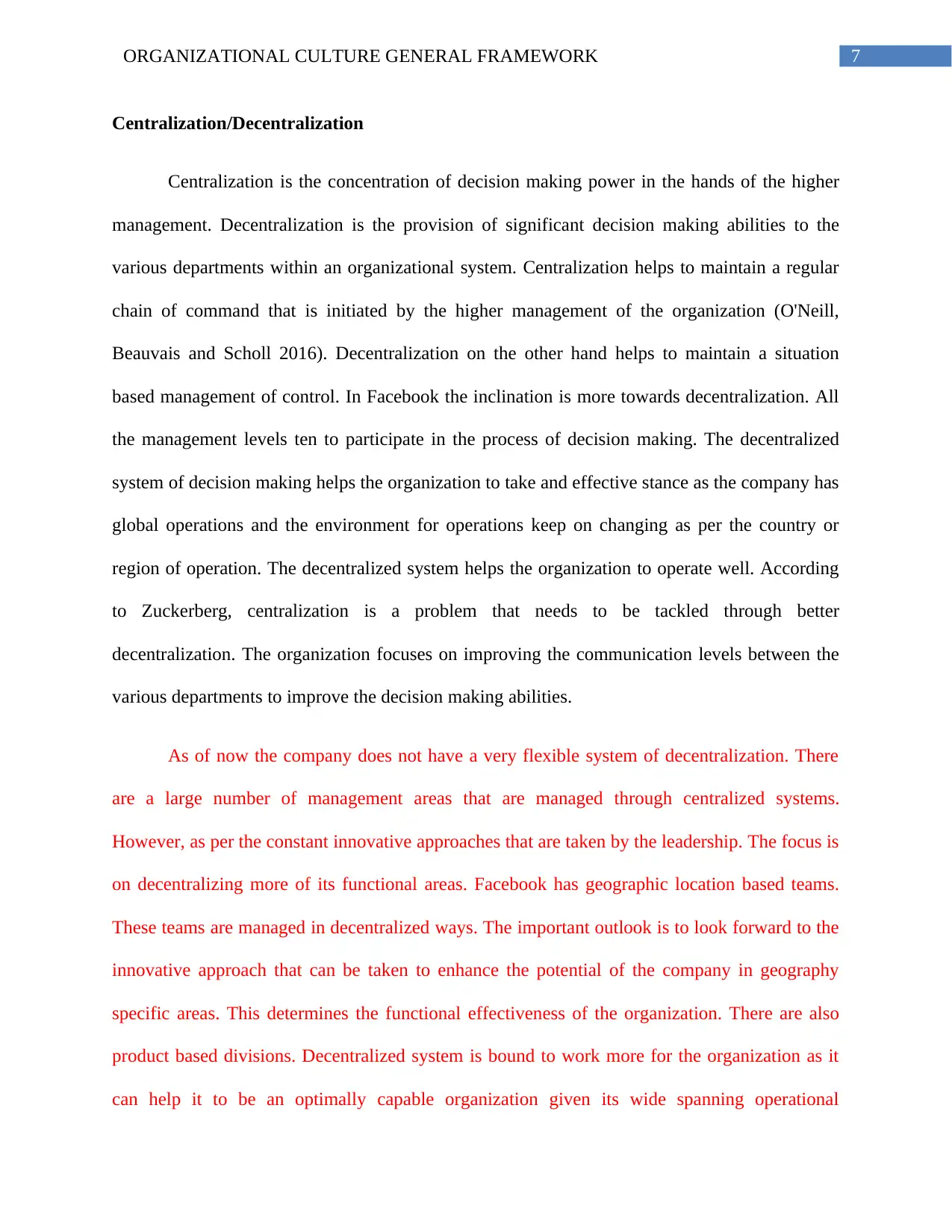
7ORGANIZATIONAL CULTURE GENERAL FRAMEWORK
Centralization/Decentralization
Centralization is the concentration of decision making power in the hands of the higher
management. Decentralization is the provision of significant decision making abilities to the
various departments within an organizational system. Centralization helps to maintain a regular
chain of command that is initiated by the higher management of the organization (O'Neill,
Beauvais and Scholl 2016). Decentralization on the other hand helps to maintain a situation
based management of control. In Facebook the inclination is more towards decentralization. All
the management levels ten to participate in the process of decision making. The decentralized
system of decision making helps the organization to take and effective stance as the company has
global operations and the environment for operations keep on changing as per the country or
region of operation. The decentralized system helps the organization to operate well. According
to Zuckerberg, centralization is a problem that needs to be tackled through better
decentralization. The organization focuses on improving the communication levels between the
various departments to improve the decision making abilities.
As of now the company does not have a very flexible system of decentralization. There
are a large number of management areas that are managed through centralized systems.
However, as per the constant innovative approaches that are taken by the leadership. The focus is
on decentralizing more of its functional areas. Facebook has geographic location based teams.
These teams are managed in decentralized ways. The important outlook is to look forward to the
innovative approach that can be taken to enhance the potential of the company in geography
specific areas. This determines the functional effectiveness of the organization. There are also
product based divisions. Decentralized system is bound to work more for the organization as it
can help it to be an optimally capable organization given its wide spanning operational
Centralization/Decentralization
Centralization is the concentration of decision making power in the hands of the higher
management. Decentralization is the provision of significant decision making abilities to the
various departments within an organizational system. Centralization helps to maintain a regular
chain of command that is initiated by the higher management of the organization (O'Neill,
Beauvais and Scholl 2016). Decentralization on the other hand helps to maintain a situation
based management of control. In Facebook the inclination is more towards decentralization. All
the management levels ten to participate in the process of decision making. The decentralized
system of decision making helps the organization to take and effective stance as the company has
global operations and the environment for operations keep on changing as per the country or
region of operation. The decentralized system helps the organization to operate well. According
to Zuckerberg, centralization is a problem that needs to be tackled through better
decentralization. The organization focuses on improving the communication levels between the
various departments to improve the decision making abilities.
As of now the company does not have a very flexible system of decentralization. There
are a large number of management areas that are managed through centralized systems.
However, as per the constant innovative approaches that are taken by the leadership. The focus is
on decentralizing more of its functional areas. Facebook has geographic location based teams.
These teams are managed in decentralized ways. The important outlook is to look forward to the
innovative approach that can be taken to enhance the potential of the company in geography
specific areas. This determines the functional effectiveness of the organization. There are also
product based divisions. Decentralized system is bound to work more for the organization as it
can help it to be an optimally capable organization given its wide spanning operational
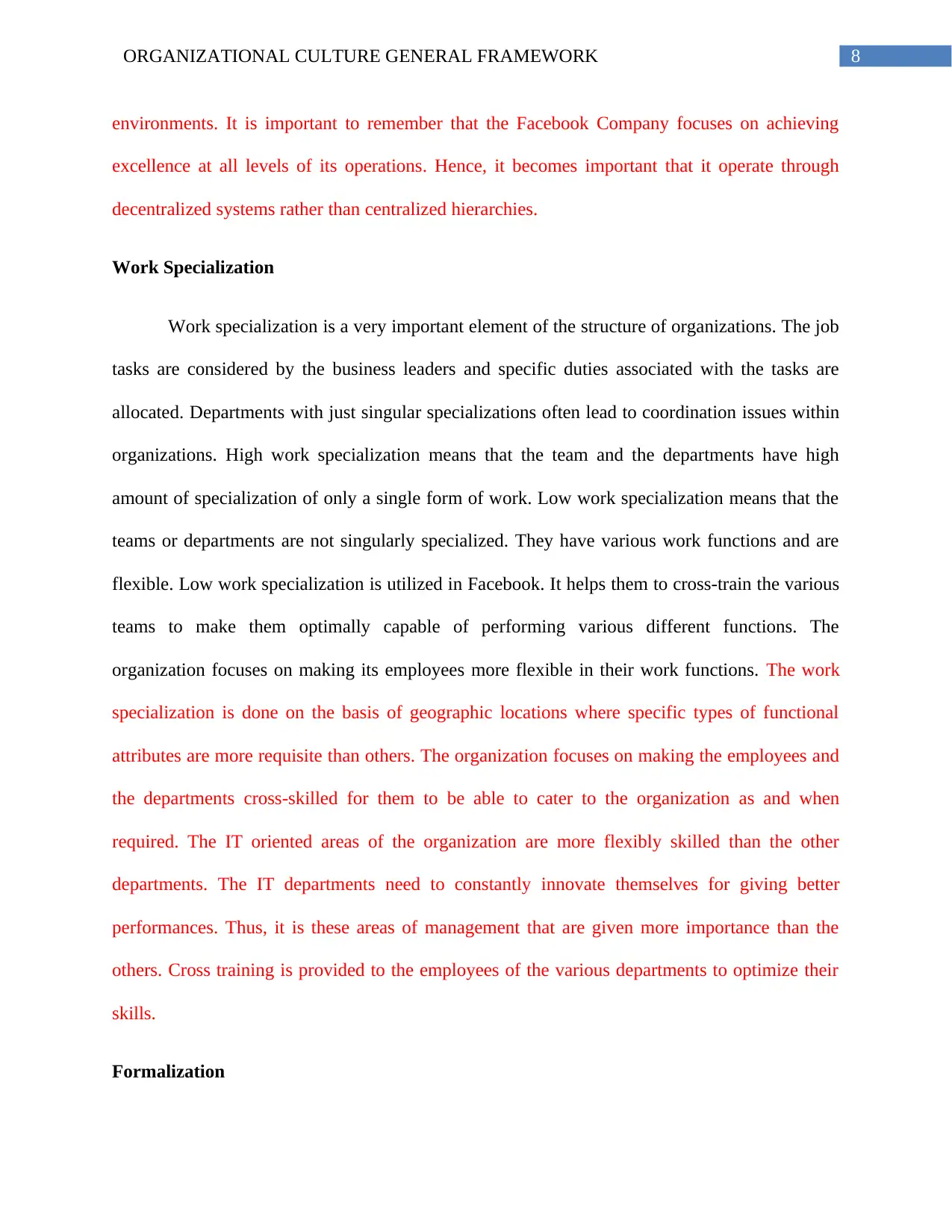
8ORGANIZATIONAL CULTURE GENERAL FRAMEWORK
environments. It is important to remember that the Facebook Company focuses on achieving
excellence at all levels of its operations. Hence, it becomes important that it operate through
decentralized systems rather than centralized hierarchies.
Work Specialization
Work specialization is a very important element of the structure of organizations. The job
tasks are considered by the business leaders and specific duties associated with the tasks are
allocated. Departments with just singular specializations often lead to coordination issues within
organizations. High work specialization means that the team and the departments have high
amount of specialization of only a single form of work. Low work specialization means that the
teams or departments are not singularly specialized. They have various work functions and are
flexible. Low work specialization is utilized in Facebook. It helps them to cross-train the various
teams to make them optimally capable of performing various different functions. The
organization focuses on making its employees more flexible in their work functions. The work
specialization is done on the basis of geographic locations where specific types of functional
attributes are more requisite than others. The organization focuses on making the employees and
the departments cross-skilled for them to be able to cater to the organization as and when
required. The IT oriented areas of the organization are more flexibly skilled than the other
departments. The IT departments need to constantly innovate themselves for giving better
performances. Thus, it is these areas of management that are given more importance than the
others. Cross training is provided to the employees of the various departments to optimize their
skills.
Formalization
environments. It is important to remember that the Facebook Company focuses on achieving
excellence at all levels of its operations. Hence, it becomes important that it operate through
decentralized systems rather than centralized hierarchies.
Work Specialization
Work specialization is a very important element of the structure of organizations. The job
tasks are considered by the business leaders and specific duties associated with the tasks are
allocated. Departments with just singular specializations often lead to coordination issues within
organizations. High work specialization means that the team and the departments have high
amount of specialization of only a single form of work. Low work specialization means that the
teams or departments are not singularly specialized. They have various work functions and are
flexible. Low work specialization is utilized in Facebook. It helps them to cross-train the various
teams to make them optimally capable of performing various different functions. The
organization focuses on making its employees more flexible in their work functions. The work
specialization is done on the basis of geographic locations where specific types of functional
attributes are more requisite than others. The organization focuses on making the employees and
the departments cross-skilled for them to be able to cater to the organization as and when
required. The IT oriented areas of the organization are more flexibly skilled than the other
departments. The IT departments need to constantly innovate themselves for giving better
performances. Thus, it is these areas of management that are given more importance than the
others. Cross training is provided to the employees of the various departments to optimize their
skills.
Formalization
⊘ This is a preview!⊘
Do you want full access?
Subscribe today to unlock all pages.

Trusted by 1+ million students worldwide
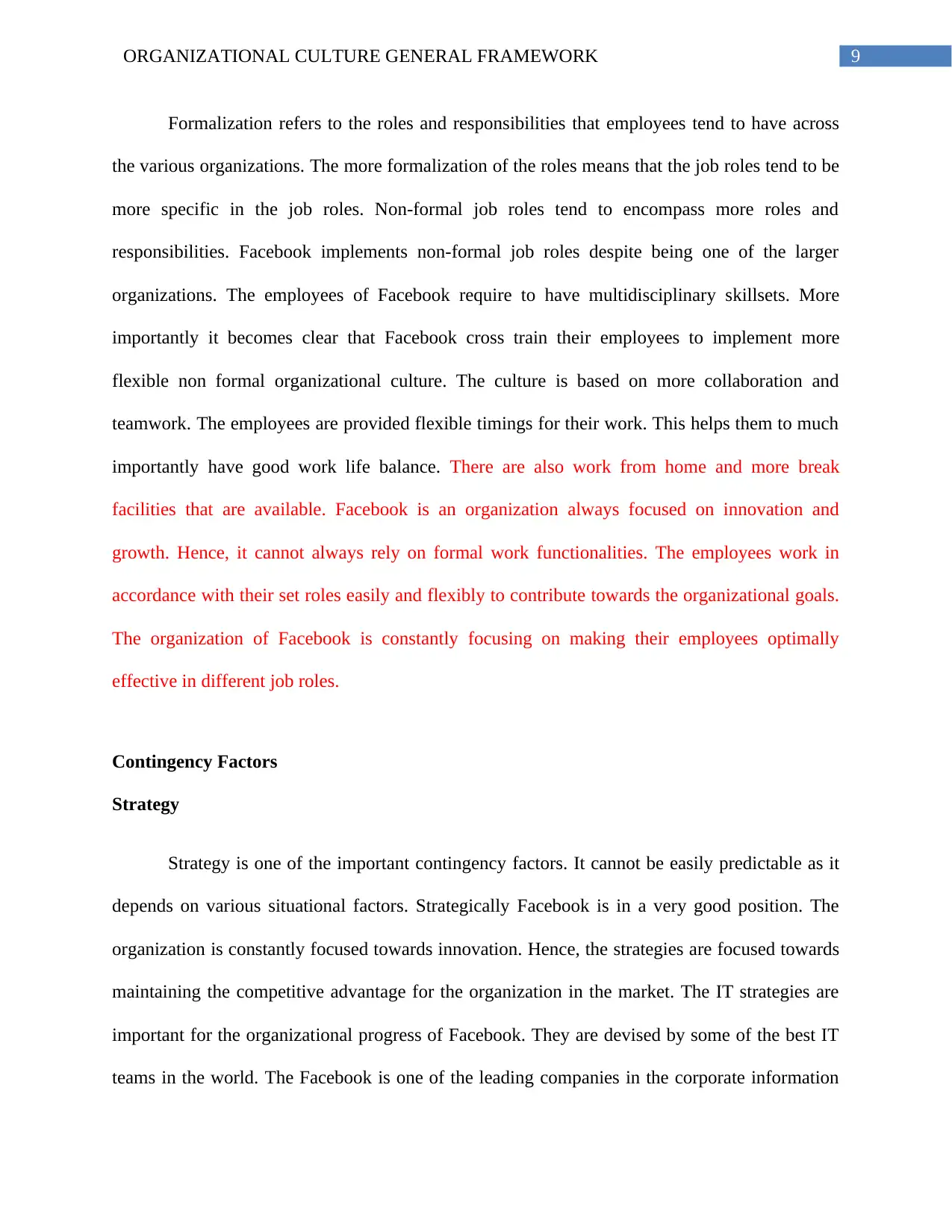
9ORGANIZATIONAL CULTURE GENERAL FRAMEWORK
Formalization refers to the roles and responsibilities that employees tend to have across
the various organizations. The more formalization of the roles means that the job roles tend to be
more specific in the job roles. Non-formal job roles tend to encompass more roles and
responsibilities. Facebook implements non-formal job roles despite being one of the larger
organizations. The employees of Facebook require to have multidisciplinary skillsets. More
importantly it becomes clear that Facebook cross train their employees to implement more
flexible non formal organizational culture. The culture is based on more collaboration and
teamwork. The employees are provided flexible timings for their work. This helps them to much
importantly have good work life balance. There are also work from home and more break
facilities that are available. Facebook is an organization always focused on innovation and
growth. Hence, it cannot always rely on formal work functionalities. The employees work in
accordance with their set roles easily and flexibly to contribute towards the organizational goals.
The organization of Facebook is constantly focusing on making their employees optimally
effective in different job roles.
Contingency Factors
Strategy
Strategy is one of the important contingency factors. It cannot be easily predictable as it
depends on various situational factors. Strategically Facebook is in a very good position. The
organization is constantly focused towards innovation. Hence, the strategies are focused towards
maintaining the competitive advantage for the organization in the market. The IT strategies are
important for the organizational progress of Facebook. They are devised by some of the best IT
teams in the world. The Facebook is one of the leading companies in the corporate information
Formalization refers to the roles and responsibilities that employees tend to have across
the various organizations. The more formalization of the roles means that the job roles tend to be
more specific in the job roles. Non-formal job roles tend to encompass more roles and
responsibilities. Facebook implements non-formal job roles despite being one of the larger
organizations. The employees of Facebook require to have multidisciplinary skillsets. More
importantly it becomes clear that Facebook cross train their employees to implement more
flexible non formal organizational culture. The culture is based on more collaboration and
teamwork. The employees are provided flexible timings for their work. This helps them to much
importantly have good work life balance. There are also work from home and more break
facilities that are available. Facebook is an organization always focused on innovation and
growth. Hence, it cannot always rely on formal work functionalities. The employees work in
accordance with their set roles easily and flexibly to contribute towards the organizational goals.
The organization of Facebook is constantly focusing on making their employees optimally
effective in different job roles.
Contingency Factors
Strategy
Strategy is one of the important contingency factors. It cannot be easily predictable as it
depends on various situational factors. Strategically Facebook is in a very good position. The
organization is constantly focused towards innovation. Hence, the strategies are focused towards
maintaining the competitive advantage for the organization in the market. The IT strategies are
important for the organizational progress of Facebook. They are devised by some of the best IT
teams in the world. The Facebook is one of the leading companies in the corporate information
Paraphrase This Document
Need a fresh take? Get an instant paraphrase of this document with our AI Paraphraser
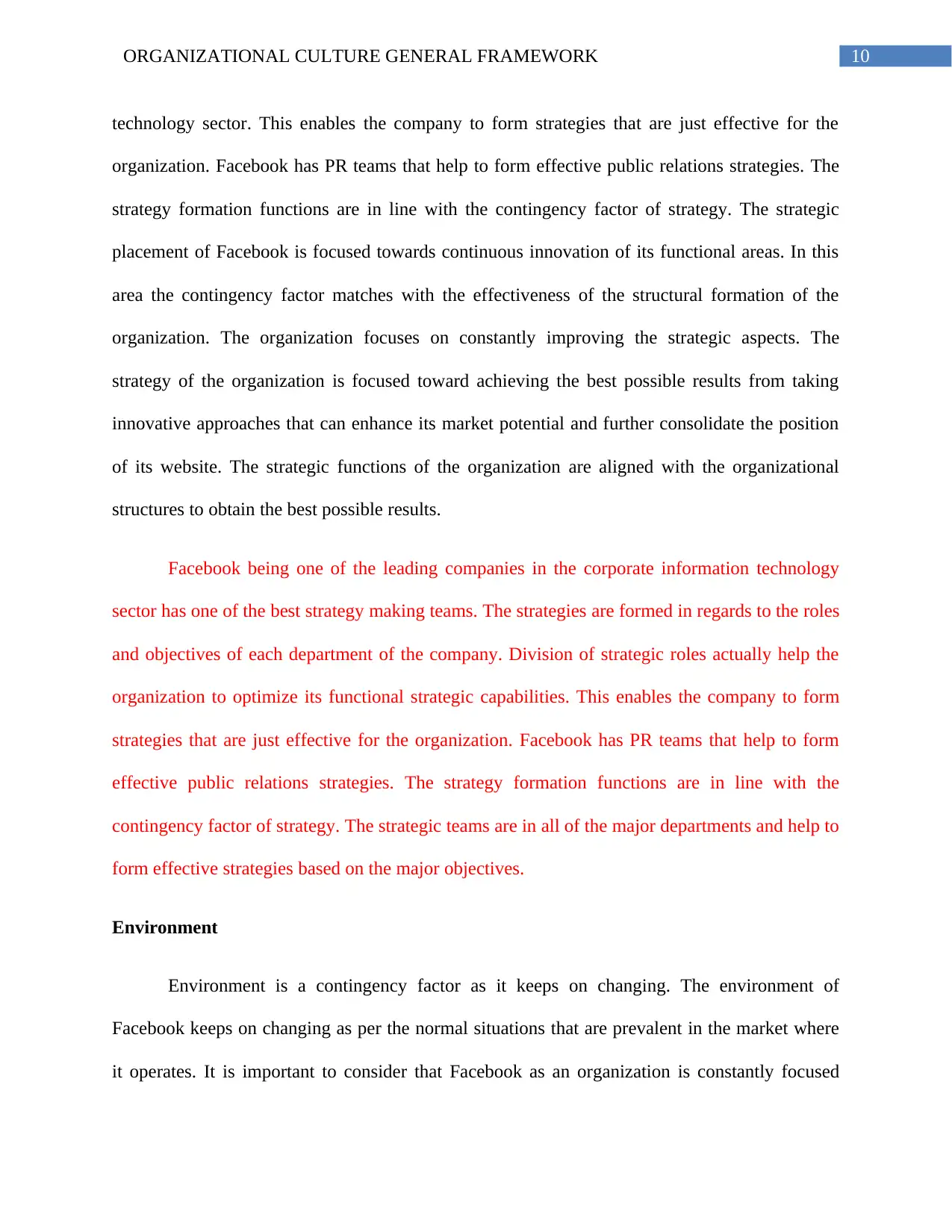
10ORGANIZATIONAL CULTURE GENERAL FRAMEWORK
technology sector. This enables the company to form strategies that are just effective for the
organization. Facebook has PR teams that help to form effective public relations strategies. The
strategy formation functions are in line with the contingency factor of strategy. The strategic
placement of Facebook is focused towards continuous innovation of its functional areas. In this
area the contingency factor matches with the effectiveness of the structural formation of the
organization. The organization focuses on constantly improving the strategic aspects. The
strategy of the organization is focused toward achieving the best possible results from taking
innovative approaches that can enhance its market potential and further consolidate the position
of its website. The strategic functions of the organization are aligned with the organizational
structures to obtain the best possible results.
Facebook being one of the leading companies in the corporate information technology
sector has one of the best strategy making teams. The strategies are formed in regards to the roles
and objectives of each department of the company. Division of strategic roles actually help the
organization to optimize its functional strategic capabilities. This enables the company to form
strategies that are just effective for the organization. Facebook has PR teams that help to form
effective public relations strategies. The strategy formation functions are in line with the
contingency factor of strategy. The strategic teams are in all of the major departments and help to
form effective strategies based on the major objectives.
Environment
Environment is a contingency factor as it keeps on changing. The environment of
Facebook keeps on changing as per the normal situations that are prevalent in the market where
it operates. It is important to consider that Facebook as an organization is constantly focused
technology sector. This enables the company to form strategies that are just effective for the
organization. Facebook has PR teams that help to form effective public relations strategies. The
strategy formation functions are in line with the contingency factor of strategy. The strategic
placement of Facebook is focused towards continuous innovation of its functional areas. In this
area the contingency factor matches with the effectiveness of the structural formation of the
organization. The organization focuses on constantly improving the strategic aspects. The
strategy of the organization is focused toward achieving the best possible results from taking
innovative approaches that can enhance its market potential and further consolidate the position
of its website. The strategic functions of the organization are aligned with the organizational
structures to obtain the best possible results.
Facebook being one of the leading companies in the corporate information technology
sector has one of the best strategy making teams. The strategies are formed in regards to the roles
and objectives of each department of the company. Division of strategic roles actually help the
organization to optimize its functional strategic capabilities. This enables the company to form
strategies that are just effective for the organization. Facebook has PR teams that help to form
effective public relations strategies. The strategy formation functions are in line with the
contingency factor of strategy. The strategic teams are in all of the major departments and help to
form effective strategies based on the major objectives.
Environment
Environment is a contingency factor as it keeps on changing. The environment of
Facebook keeps on changing as per the normal situations that are prevalent in the market where
it operates. It is important to consider that Facebook as an organization is constantly focused
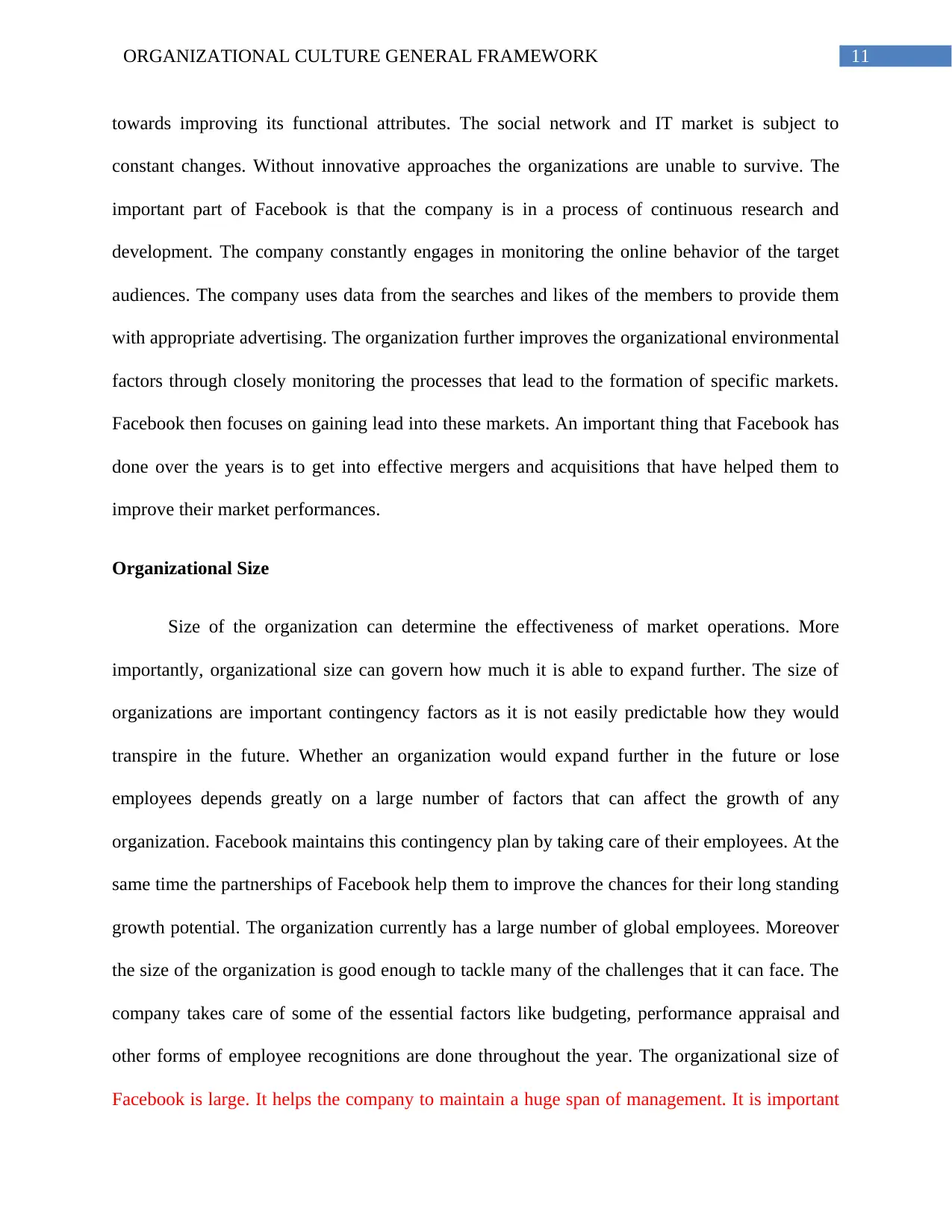
11ORGANIZATIONAL CULTURE GENERAL FRAMEWORK
towards improving its functional attributes. The social network and IT market is subject to
constant changes. Without innovative approaches the organizations are unable to survive. The
important part of Facebook is that the company is in a process of continuous research and
development. The company constantly engages in monitoring the online behavior of the target
audiences. The company uses data from the searches and likes of the members to provide them
with appropriate advertising. The organization further improves the organizational environmental
factors through closely monitoring the processes that lead to the formation of specific markets.
Facebook then focuses on gaining lead into these markets. An important thing that Facebook has
done over the years is to get into effective mergers and acquisitions that have helped them to
improve their market performances.
Organizational Size
Size of the organization can determine the effectiveness of market operations. More
importantly, organizational size can govern how much it is able to expand further. The size of
organizations are important contingency factors as it is not easily predictable how they would
transpire in the future. Whether an organization would expand further in the future or lose
employees depends greatly on a large number of factors that can affect the growth of any
organization. Facebook maintains this contingency plan by taking care of their employees. At the
same time the partnerships of Facebook help them to improve the chances for their long standing
growth potential. The organization currently has a large number of global employees. Moreover
the size of the organization is good enough to tackle many of the challenges that it can face. The
company takes care of some of the essential factors like budgeting, performance appraisal and
other forms of employee recognitions are done throughout the year. The organizational size of
Facebook is large. It helps the company to maintain a huge span of management. It is important
towards improving its functional attributes. The social network and IT market is subject to
constant changes. Without innovative approaches the organizations are unable to survive. The
important part of Facebook is that the company is in a process of continuous research and
development. The company constantly engages in monitoring the online behavior of the target
audiences. The company uses data from the searches and likes of the members to provide them
with appropriate advertising. The organization further improves the organizational environmental
factors through closely monitoring the processes that lead to the formation of specific markets.
Facebook then focuses on gaining lead into these markets. An important thing that Facebook has
done over the years is to get into effective mergers and acquisitions that have helped them to
improve their market performances.
Organizational Size
Size of the organization can determine the effectiveness of market operations. More
importantly, organizational size can govern how much it is able to expand further. The size of
organizations are important contingency factors as it is not easily predictable how they would
transpire in the future. Whether an organization would expand further in the future or lose
employees depends greatly on a large number of factors that can affect the growth of any
organization. Facebook maintains this contingency plan by taking care of their employees. At the
same time the partnerships of Facebook help them to improve the chances for their long standing
growth potential. The organization currently has a large number of global employees. Moreover
the size of the organization is good enough to tackle many of the challenges that it can face. The
company takes care of some of the essential factors like budgeting, performance appraisal and
other forms of employee recognitions are done throughout the year. The organizational size of
Facebook is large. It helps the company to maintain a huge span of management. It is important
⊘ This is a preview!⊘
Do you want full access?
Subscribe today to unlock all pages.

Trusted by 1+ million students worldwide
1 out of 16
Related Documents
Your All-in-One AI-Powered Toolkit for Academic Success.
+13062052269
info@desklib.com
Available 24*7 on WhatsApp / Email
![[object Object]](/_next/static/media/star-bottom.7253800d.svg)
Unlock your academic potential
Copyright © 2020–2025 A2Z Services. All Rights Reserved. Developed and managed by ZUCOL.




